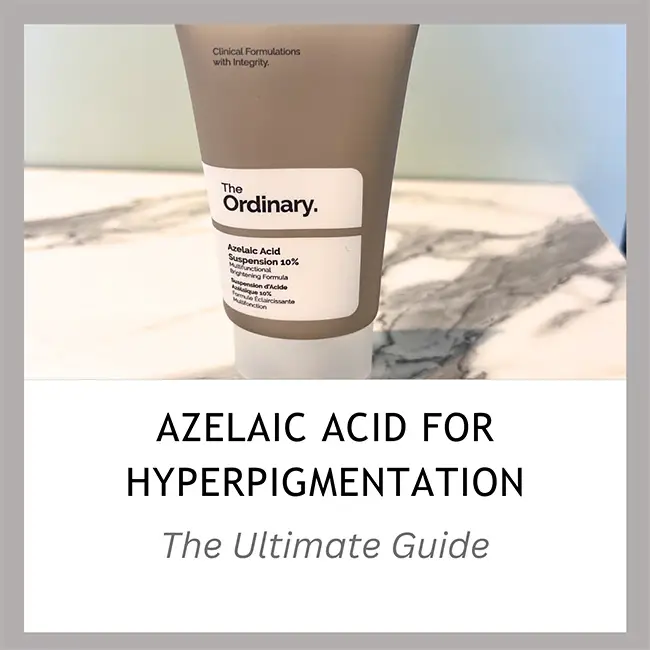
Hyperpigmentation remains one of the most common problems people face when it comes to skincare. Though difficult, it is not impossible to manage and one of the lesser-known, yet highly effective treatment in this arena is azelaic acid.
In this guide, you will discover everything about azelaic acid, its benefits, action against forms of hyperpigmentation such as melasma, and dark underarms, and most importantly how to harness azelaic acid for a brighter, clearer complexion.
Table of Contents
- Understanding Azelaic Acid
- Benefits of Azelaic Acid
- How does azelaic acid work for hyperpigmentation?
- Azelaic Acid: A Comprehensive Solution for Various Forms of Hyperpigmentation
- Comparing Azelaic Acid with other hyperpigmentation treatments
- How to use azelaic acid to treat hyperpigmentation
- FAQs
Understanding Azelaic Acid
What is azelaic acid?
Azelaic acid is a dicarboxylic acid (an organic compound that contains two carboxyl groups), produced by a type of yeast known as Malassezia furfur (previously called Pityrosporum ovale). This yeast is a part of the normal skin flora, meaning it usually lives on our skin without causing any issues and contributes to maintaining a healthy skin microbiome.
Uses of Azelaic Acid
The versatility of azelaic acid is what makes it remarkable. It can be used as an effective treatment for a wide range of inflammatory skin conditions such as rosacea, acne, seborrheic dermatitis, and hyperpigmentation. Added to that its exfoliating properties help to accelerate skin cell turnover rate, unclog pores, and brighten the skin. It is also an antioxidant, providing the skin with protection against free radical damage and UV exposure.
Azelaic acid is unique because, unlike many other skincare acids, it is very stable and gentle enough to be used by all skin types including on sensitive skin and during pregnancy. Below is a detailed breakdown of the benefits of azelaic acid for the skin.
Benefits of Azelaic Acid
Antimicrobial Action
Azelaic acid is known to be bacteriostatic (an agent that stops bacteria from reproducing), meaning it inhibits the growth or multiplication of bacteria on the skin. It has been proven to be able to stop the growth rate, inhibit and kill Propionibacterium acnes and Staphylococcus epidermidis, two bacteria linked to the cause of acne in follicles.
Anti-Inflammatory Properties
Azelaic acid helps to reduce inflammation and redness, making it beneficial for conditions like rosacea and acne. In a 2010 study, it was found effective in reducing inflammation of human skin cells induced by UVB light.
In another study, a 20% azelaic acid cream and 15% azelaic acid gel were found to be an effective treatment for papulopustular rosacea and resulted in a reduction of inflamed lesions and participant’s skin as well as the reduced severity of inflammation on the skin.
Hyperpigmentation Treatment
Azelaic acid has been proven to inhibit melanin synthesis by affecting tyrosinase, the enzyme responsible for excess melanin production in the skin which is the root cause of hyperpigmentation.
A study in the British Journal of Dermatology (1991) reported that a 20% concentration of azelaic acid was comparable to 4% hydroquinone in treating melasma, without the associated side effects of hydroquinone.
It should be noted that hydroquinone remains the gold standard treatment for hyperpigmentation but has severe side effects. Azelaic acid, therefore, represents a safer alternative to treating hyperpigmentation in total safety.
Reduces Keratin Production
Azelaic acid is also classified as a keratolytic compound. This means it has the ability to regulate and prevent the production of excess keratin in the skin which can build up and cause rough, bumpy and dry skin.
Its ability to speed up the skin’s renewal process helps exfoliate the skin gently and makes azelaic acid a good treatment option for disorders marked by abnormal keratinization, like certain types of acne, keratosis pilaris and rosacea.
How does azelaic acid work for hyperpigmentation?
Hyperpigmentation is a condition characterized by darkened patches of skin, usually a result of an overproduction of melanin, the pigment responsible for skin, hair, and eye color. This can occur due to various factors such as sun exposure, inflammation, hormonal changes, or skin injuries.
Azelaic acid works against hyperpigmentation primarily through its impact on melanogenesis, the process responsible for melanin production. It selectively inhibits the activity of tyrosinase, a key enzyme involved in the synthesis of melanin. By hindering this enzyme, azelaic acid can help regulate melanin production and reduce the development of hyperpigmented spots on the skin.
What makes azelaic acid unique is that it specifically targets hyperactive melanocytes (the cells that produce melanin), without affecting the normally functioning ones. This means it can lighten areas of hyperpigmentation without significantly altering the overall skin color, making it a safe option for individuals with various skin types and colors.
Moreover, azelaic acid has anti-inflammatory properties, which can be beneficial as inflammation can often stimulate excess melanin production. By reducing inflammation, azelaic acid helps mitigate one of the potential causes of hyperpigmentation.
Azelaic Acid: A Comprehensive Solution for Various Forms of Hyperpigmentation
There are various forms of hyperpigmentation that differ in cause. In this section, we will look at these various forms of hyperpigmentation and how azelaic acid action to treat them.
Azelaic acid for melasma
Melasma is a common skin condition characterized by the appearance of brown or gray-brown patches, predominantly on the face. The exact cause is unclear, but it’s often linked to an overproduction of melanin triggered by factors such as sun exposure, hormonal changes (like pregnancy or birth control), genetic predisposition, certain skin types, and irritation from skincare products.
Azelaic acid helps treat melasma by inhibiting tyrosinase and stopping the formation of excess melanin in the skin. In a 1996 study, 20% azelaic acid was found to be more effective than 2% hydroquinone and as effective as 4% hydroquinone in treating melasma.
Its action is targeted, affecting only hyperactive melanocytes, thus lightening hyperpigmented areas without altering overall skin color. Azelaic acid’s anti-inflammatory properties also address inflammation, a potential melasma trigger.
Azelaic acid for Post-Inflammatory Hyperpigmentation (PIH)
Post-Inflammatory Hyperpigmentation (PIH) is a condition where your skin gets darker in spots where it was previously inflamed or injured. PIH mainly refers to hyperpigmentation caused by acne scars, dark spots, burn scars, contact allergy or any discoloration left on the skin after an injury. Azelaic acid’s direct tyrosinase-inhibiting properties make it a first-line treatment to get rid of post-inflammatory discolorations on the skin.
Azelaic acid for dark underarms
The armpits are one of the areas of the body most prone to hyperpigmentation due to constant friction. And just like other forms of hyperpigmentation using skin-brightening actives like azelaic acid can help brighten your underarms.
However, you should note there exists a risk of irritation when applying azelaic acid-based products to your armpit as this part of the body has a very high absorption rate which increases the risk of irritation. Make sure to start with products at a low percentage.
Comparing Azelaic Acid with other hyperpigmentation treatments
A diverse array of treatments exists for hyperpigmentation, each with its own mechanism of action, benefits, and potential drawbacks. In this section, we will delve into an in-depth comparison of azelaic acid with other common treatments for hyperpigmentation, including, retinol, niacinamide, and glycolic acid.
1. Azelaic Acid vs. Retinol for hyperpigmentation
Retinol is a frequently recommended active ingredient for addressing issues like acne and hyperpigmentation. Unlike azelaic acid, which inhibits melanin production, retinol works to reduce hyperpigmentation by accelerating skin cell turnover. In doing so, it promotes the shedding of the top, often more pigmented, layers of the skin, fostering the growth of new, less pigmented skin. Nevertheless, retinol can potentially cause skin irritation, particularly at higher concentrations, and is known to induce purging.
2. Azelaic Acid vs. Niacinamide for hyperpigmentation
Azelaic acid and niacinamide, both respected ingredients in skincare, work differently to address hyperpigmentation.
Azelaic acid, known for its brightening and skin-clearing properties, directly suppresses the activity of an enzyme involved in melanin production. By inhibiting this enzyme, azelaic acid reduces melanin synthesis, leading to a decrease in hyperpigmentation over time.
On the other hand, niacinamide, or Vitamin B3, tackles hyperpigmentation by inhibiting melanosome transfer from melanocytes (cells that produce melanin) to keratinocytes (cells in the outermost layer of the skin). This process results in a reduction in the appearance of hyperpigmentation. It is often well-tolerated, making it a viable option for those with sensitive skin.
Despite their different mechanisms of action, both azelaic acid and niacinamide are effective against hyperpigmentation. They can be used in combination, offering a dual approach to treating hyperpigmentation.
Furthermore, unlike azelaic acid, niacinamide also has the added benefit of helping to reduce inflammation and improve the skin’s barrier function, which can further enhance the overall health and appearance of the skin.
3. Azelaic Acid vs. Glycolic Acid for hyperpigmentation
Azelaic acid and glycolic acid also both treat hyperpigmentation albeit in different ways. Azelaic acid directly inhibits tyrosinase, the enzyme responsible for melanin production, thereby addressing the root cause of hyperpigmentation.
In contrast, glycolic acid, an alpha-hydroxy acid, acts primarily as an exfoliant, aiding the removal of pigmented skin layers to reveal fresher skin beneath. In terms of potency, glycolic acid can be more irritating due to its exfoliating nature, making azelaic acid a gentler option for sensitive skin types.
Nevertheless, combining these two ingredients in a skincare routine could potentially yield even better results. For example, using a product with glycolic acid to exfoliate and prep the skin, followed by a product with azelaic acid, could maximize the skin-brightening effects.
How to use azelaic acid to treat hyperpigmentation
Azelaic acid can generally be used once or twice a day. It’s usually recommended to start slowly, applying it every other day to assess your skin’s tolerance, before ramping up to daily use.
Apply your azelaic acid-based product in the morning or evening, depending on your preference and skincare routine. After cleansing your skin and applying any toners or serums, apply a pea-sized amount of azelaic acid to your face. Be sure to focus on areas of hyperpigmentation, but you can use it on your entire face to maintain an even skin tone.
Pairing azelaic acid with other hyperpigmentation treatments
Treating hyperpigmentation usually requires the combination of various brightening actives that work in various ways. One of the greatest benefits of azelaic acid is that it is generally well tolerated and can be used with other hyperpigmentation treatments like retinol, vitamin C, arbutin, kojic acid, hydroquinone, glycolic acid, and niacinamide for better results.
However, be careful when combining azelaic acid with other potent actives like retinoids, as it may increase skin sensitivity. It’s always best to do a patch test or consult with a dermatologist.
Most importantly, if you’re using azelaic acid in the morning, be sure to apply a broad-spectrum sunscreen afterwards, as azelaic acid, like other active ingredients, can make your skin more sensitive to the sun.
Avoid using azelaic acid on broken skin or areas of eczema, as it may cause irritation. If you notice any signs of irritation such as redness, itching, or peeling, discontinue use and consult with a dermatologist.
Remember that results won’t be visible overnight – it may take several weeks to see improvements in hyperpigmentation. Be patient and consistent with your application.
FAQs
How long does it take for azelaic acid to work on hyperpigmentation?
The effectiveness and time frame of azelaic acid’s impact on hyperpigmentation can vary considerably based on individual skin types and the severity of the condition. However, as a guideline, most users typically begin to observe noticeable improvements in their skin tone and hyperpigmentation after consistent use over a period of 1-3 months.
It is important to note that this is a gradual process, and for optimal results, azelaic acid should be used consistently and incorporated as part of a regular skincare regimen. Additionally, its effectiveness can be enhanced when used in combination with other skin-brightening ingredients. Patience and consistency are key when using azelaic acid for hyperpigmentation treatment.
How effective is azelaic acid for hyperpigmentation?
Azelaic acid is recognized as a potent treatment for hyperpigmentation, owing to its ability to inhibit the enzyme tyrosinase, thereby controlling melanin production. Its effectiveness, however, can differ significantly from one individual to another, as it is influenced by factors such as the severity of hyperpigmentation, the skin’s absorption rate, and the individual’s skin type and response to the product.
While azelaic acid is a powerful agent on its own, its impact can be potentially amplified when used synergistically with other skin-lightening ingredients, offering a comprehensive approach to hyperpigmentation treatment.
In essence, azelaic acid is effective against hyperpigmentation, but for best results, it should be part of a comprehensive, personalized skincare routine that might include other complementary ingredients. Additionally, consistency of use and patience will greatly enhance the outcomes.
Does azelaic acid help with post-inflammatory hyperpigmentation?
Absolutely, azelaic acid is particularly beneficial in addressing post-inflammatory hyperpigmentation (PIH). It operates by blocking tyrosinase, an enzyme crucial in melanin production, hence reducing the excess pigment production that characterizes PIH.
Furthermore, azelaic acid boasts anti-inflammatory properties that can help soothe and calm inflamed skin, thereby indirectly helping to prevent the onset of PIH, which often follows inflammation.
In sum, not only can azelaic acid aid in fading existing hyperpigmentation, but its use can also potentially mitigate the conditions that lead to its development in the first place. However, it’s important to remember that results can vary from person to person, and consistent, regular use is key to achieving desired outcomes.
What percentage of azelaic acid is effective for hyperpigmentation?
Azelaic acid products are typically found in concentrations ranging from 10% to 20%. These concentrations have been proven effective in treating hyperpigmentation.
Specifically, a 20% concentration is often prescribed for more severe or persistent cases, while a 10% concentration may be suitable for milder cases or for those with sensitive skin.
However, individual responses can vary, and it’s essential to consult with a dermatologist or skincare specialist to determine the most appropriate concentration for your unique skin needs.
Is 10% azelaic acid effective for hyperpigmentation?
Absolutely, a 10% azelaic acid formulation can indeed be effective in managing hyperpigmentation. However, it’s important to remember that skin response can differ among individuals, and the effectiveness of a 10% formulation may depend on factors such as the extent and type of hyperpigmentation, your overall skin health, and how consistent you are with usage.
As always, it is beneficial to consult with a dermatologist or skincare professional to develop a personalized treatment plan that will optimally address your skin concerns.
Can azelaic acid remove hyperpigmentation?
While azelaic acid can help lighten hyperpigmentation, it may not be able to completely remove it. Results vary based on the severity of the hyperpigmentation and individual skin response.

Petra Nakashian (previously Kravos) is a dedicated natural health and beauty blogger, driven by the loss of her parents to cancer, which led her to meticulously research beauty product ingredients. With over 10 years of experience, her in-depth knowledge has made her a trusted expert in the field. Founder of Be Healthy Now and Green Beauty Talk, Petra recently expanded her expertise with Beauty Insights Hub, exploring a wider range of beauty treatments. Committed to transparency and honesty, her work is a vital resource for navigating the complex world of beauty.

